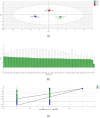Investigation of the differences in volatile organic compounds of sesame oil under different processing methods using GC-IMS and electronic nose
- PMID: 40823037
- PMCID: PMC12354378
- DOI: 10.3389/fnut.2025.1611006
Investigation of the differences in volatile organic compounds of sesame oil under different processing methods using GC-IMS and electronic nose
Abstract
Introduction: Sesame oil is an edible oil of high economic and nutritional value, possessing a unique flavor and exerting various physiological effects, including antioxidant, anti-inflammatory, and hypoglycemic effects. Flavor compounds are essential in evaluating the taste and quality of food. To explore the impacts of water substitution method, cold-pressing method, and hot-pressing method on the volatile organic components and active aroma components of sesame oil.
Methods: This study employed the Heracles Neo ultra-fast gas-phase electronic nose and GC-IMS technology, combined with chemometric analysis, to analyze the volatile organic compounds (VOCs) of three groups of sesame oil samples.
Results: A total of 74 VOCs were detected in the three sesame oil samples, which were from GC-IMS and Heracles NEO ultra-fast gas-phase electronic nose (60 VOCs were detected via GC-IMS, 22 VOCs were detected via GC-IMS, among them, 8 VOCs were simultaneously detected via GC-IMS and Heracles NEO ultra-fast gas-phase electronic nose). The sesame oil produced via the water substitution method was rich in more than 42 VOCs, including Cyclopentanone, 1-Pentanol and had a more unique and richer flavor; the sesame oil produced via the cold-pressing method contains 4 VOCs, for example, γ -terpinene with an original fruity flavor; and the sesame oil processed by the hot-pressing method was rich in 29 VOCs, including 2-methyl-1-propanol, and had a better fat aroma.
Discussion: This study helps to improve the quality and flavor of sesame oil from the perspective of volatile components, facilitating technological innovation and industrial upgrades.
Keywords: Heracles NEO ultra-fast gas-phase electronic nose; gas chromatography–ion mobility spectrometry; processing method; sesame oil; volatile organic compounds.
Copyright © 2025 Ai, Yin, Zhang, Yu, Liu and Huang.
Conflict of interest statement
The authors declare that the research was conducted in the absence of any commercial or financial relationships that could be construed as a potential conflict of interest.
Figures









Similar articles
-
Dynamic changes in volatile organic compounds of cherry tomato fruits during storage at different temperatures using HS-GC-IMS.Food Res Int. 2025 Oct;218:116790. doi: 10.1016/j.foodres.2025.116790. Epub 2025 Jun 12. Food Res Int. 2025. PMID: 40790653
-
Influence of Cooking Methods on Flavor Parameters and Sensory Quality of Tibetan Sheep Meat Examined Using an Electronic Nose, an Electronic Tongue, GC-IMS, and GC-MS.Foods. 2025 Jun 22;14(13):2181. doi: 10.3390/foods14132181. Foods. 2025. PMID: 40646933 Free PMC article.
-
[Analysis of volatile aroma components in tobacco by gas chromatography-mass spectrometry coupled with headspace solid phase microextraction].Se Pu. 2025 Jul;43(7):793-804. doi: 10.3724/SP.J.1123.2024.10004. Se Pu. 2025. PMID: 40610773 Free PMC article. Chinese.
-
The effect of sample site and collection procedure on identification of SARS-CoV-2 infection.Cochrane Database Syst Rev. 2024 Dec 16;12(12):CD014780. doi: 10.1002/14651858.CD014780. Cochrane Database Syst Rev. 2024. PMID: 39679851 Free PMC article.
-
[Volume and health outcomes: evidence from systematic reviews and from evaluation of Italian hospital data].Epidemiol Prev. 2013 Mar-Jun;37(2-3 Suppl 2):1-100. Epidemiol Prev. 2013. PMID: 23851286 Italian.
References
-
- Li Y. Application of fingerprint technology combined with Chemometrics in quality identification of sesame oil. Master’s thesis, Henan University of Technology, Zhengzhou, China. (2024).
-
- Sohouli MH, Haghshenas N, Hernández-Ruiz Á, Shidfar F. Consumption of sesame seeds and sesame products has favorable effects on blood glucose levels but not on insulin resistance: a systematic review and meta-analysis of controlled clinical trials. Phytother Res. (2022) 36:1126–34. doi: 10.1002/ptr.7379, PMID: - DOI - PubMed
LinkOut - more resources
Full Text Sources
Miscellaneous

